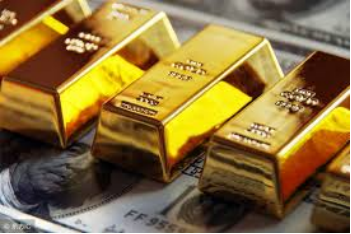The recent sell-off in gold prices has finally subsided as the Federal Reserve officially entered a period of silence ahead of its May rate meeting this week. At the same time, the risk aversion in the Asia-Pacific market has also made gold favored by many safe-haven funds.
The dollar's strength "frost kills all herbs"
But gold has lost 2.4% last week as interest rate expectations rise. At the start of the new week, expectations of rate hikes are still weighing on gold, whose safe-haven appeal is under threat. For some investors, the yield on the 10-year U.S. Treasury note has significantly outperformed gold this year as Provides fixed income returns, while gold only provides capital gains.
Although U.S. Treasury yields fell across the board on Monday, they remained relatively high, reflecting investors' growing expectations that the Federal Reserve will raise interest rates sharply in the coming months. The Fed is almost certain to raise interest rates in May and June, and may also raise interest rates in July. The US dollar index rose 0.5% to 101.73 on Monday, and the highest intraday rise was 101.86, the highest since March 2020. Now the market is hyping the Fed The expectation of raising interest rates and shrinking the balance sheet is that regardless of the Ukraine crisis or the Fed’s monetary policy, the goal is to allow more dollars to return to the U.S. stocks and U.S. bonds, then other countries will flee because of the epidemic, risk aversion, and even inflation and profit-seeking capital. It turned into a flash crash in the foreign exchange market, a flash crash in the stock index, followed by an increase in inflation and unemployment, and the wealth and funds accumulated by various countries over the years were evaporated by a forced interest rate hike and a shrinking of the balance sheet.

But in its quarterly report on gold demand trends to be released on Thursday, the World Gold Council may attest to strong investment demand for gold in the first quarter. After all, when the war in Ukraine broke out in late February, gold was in high demand as a safe haven. In addition, high and rising inflation rates have also allowed gold to shine as a store of value.
The current market is increasingly expecting the Fed to raise interest rates by at least 50 basis points in May and 50 basis points in June to deal with extremely high inflation, prompting fund managers to aggressively reduce their gold holdings and increase short positions. TD Securities warned that any additional signal from Federal Reserve Chairman Jerome Powell and other committee members that they are willing to sacrifice economic growth to control inflation will weigh on gold prices. However, this week, the Fed has entered a period of silence, and more market reactions will depend on the US GDP and PCE data before the Fed's May meeting.
Is the Fed raising interest rates "anticlimactic"?
For the recession warnings, most media outlets heavily reported the first inversion of the 2-year and 10-year Treasury yields since 2019. But all parties are currently debating the true meaning of the inverted curve. An inverted yield curve has been a recession warning since 1978.
Some studies have shown that many "economic prosperity" data are lagging behind, and there may be relatively large downward revisions in the future. Typically, the record level of any data is historical, the high or low of the previous cycle. The United States, for example, has recovered 90% of its job losses. That makes the U.S. job market sound strong, but it's not because new jobs are absorbing more labor, it's businesses rehiring for vacant positions.
Real estate is sensitive to the economy, driven by income and mortgage rates. The U.S. housing market has seen a big boom in 2021 after the economy shut down due to the pandemic, U.S. households received a flood of checks distributed by the government, and lower mortgage rates, but demand fell as mortgage rates rose. Housing inventories will rise.
The Fed was supposed to raise interest rates in 2020 and 2021 due to soaring inflation caused by excess monetary liquidity. Unfortunately, the Fed has held rates at zero for far too long, and now they are forced to act aggressively to raise rates to fight their own "inflation monster"
The yield curve is a leading indicator of current economic conditions, and economic data is "lag" and likely to be revised substantially. What's more, while consumption may continue to support economic growth, that will change dramatically when unemployment picks up. Consumers are fickle, and once consumer psychology changes, demand will shrink rapidly.
While many believe the Fed will "stay the course" to fight inflation, history has also made it clear that the Fed will not tolerate financial instability and that the Fed may return to zero interest rates and quantitative easing sooner than many expect.
 2022-04-27
2022-04-27
 1086
1086






 简体中文
简体中文
 ภาษาไทย
ภาษาไทย
 繁體中文
繁體中文
 Indonesia
Indonesia











